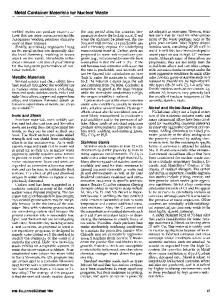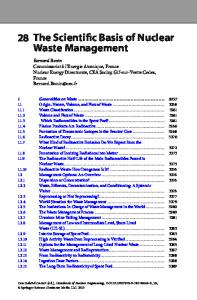Materials Research for the Canadian Nuclear Fuel Waste Management Program
- PDF / 781,927 Bytes
- 11 Pages / 420.48 x 639 pts Page_size
- 28 Downloads / 364 Views
Inc.
Stephen V. Topp,editor
MATERIALS RESEARCH FOR THE CANADIAN NUCLEAR FUEL WASTE MANAGEMENT PROGRAM DONALD J. CAMERON Atomic Energy of Canada Research Company Ltd., Whiteshell Nuclear Research Establishment, Pinawa, Manitoba, Canada ROE ILO. ABSTRACT Nuclear fuel waste disposal research in Canada is concentrating on hard-rock disposal. The research programs concerned with the man-made components of the disposal system are reviewed. Irradiated fuel and solidified reprocessing wastes are both being researched, as are durable containers, and buffer and backfill materials. This review concentrates mainly on the more scientific aspects of the research, which contribute to the selection of preferred options for the various components of the system, and which support directly or indirectly the safety analysis of the disposal concept. Some technology development is included in the program now, and this is expected to expand as confidence in the acceptability of the disposal concept grows. INTRODUCTION
Plutons or batholiths, igneous intrusives common throughout the Canadian Shield, are the geologic formations of primary interest as the potential disposal medium in the Canadian Nuclear Fuel Waste Management Program, although a watching brief is maintained on other geologic options [1]. More than 14 0 0 plutons have been identified in the Province of Ontario, where the first disposal site likely will be located, and most are granites or gabbros. The disposal concept is based on a multiple-barrier approach to inhibit dissolution and transport of radionuclides in slowly moving groundwater, which is perceived to be the only credible mechanism for their return to the environment without the intervention of man [2]. All of the commonly suggested components of such a system are being researched: waste forms, durable absolute containment, buffers and backfills to provide nearfield barriers to diffusional and advective transport, and finally the geosphere, which is a massive spatial and sorptive barrier to radionuclide migration from the vault to the biosphere. The program is financed by the Government of Canada at a level of approximately $29 million (Canadian) per year, via Atomic Energy of Canada Ltd. (AECL), through its Whiteshell Nuclear Research Establishment (WNRE). The Waste Management Division at WNRE provides technical and financial management of the program, and performs a significant fraction of the research. Other major participants in the research program are several groups within the federal department of Energy, Mines and Resources (EMR), Environment Canada and Ontario Hydro. Ontario Hydro provides a significant contribution at no cost to the research program. Managerial review is provided by a four-party co-ordinating committee composed of representatives from AECL, EMR, Ontario Hydro and the Ontario Ministry of Energy. A twelve-member review group, the Technical Advisory Committee, has been
741
742 nominated by professional associations and learned societies to provide independent scientific review of the pr
Data Loading...











